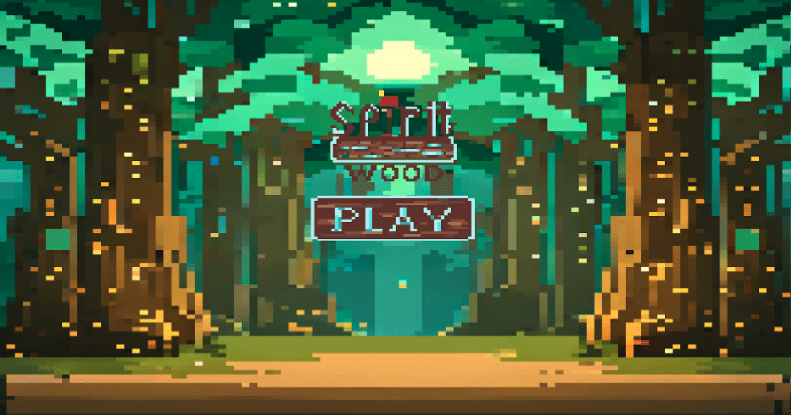Defne, Eli, Jamie, Janet, Pedro
Artist’s Statement:
You wake up in a forest, confused. “How did I get here, why am I here?” Questions rattle around in your head. You look around and realize you’re encircled by animals: a squirrel, a bunny, a turtle, and other forest critters. You gather yourself and take a step forward, expecting the forest dwellers to scurry away upon your movement. “Ah, she’s coming to her senses”, says the turtle……. Says the turtle?!?
Welcome to the Spirit Woods, a place where everything is not as it seems. Long ago, a human found their way into this enchanted forest and harnessed the power of Spirit Wood. With this power, they corrupted the animals and living beings of the forest. Now, these corrupted animals seek chaos and destruction, destroying the once-peaceful Spirit Woods. Play as the first human to step foot in the Spirit Woods in centuries. With the help of the last few uncorrupted animals, bring the corrupted animals back to the light, reverse the curse, and save the Spirit Woods!
Intentions
For our group, P2 was a chance to flex creative puzzle solving, develop Unity skills, and create in-depth narrative development. In order to do this, we needed to examine each aspect (puzzles and narrative) individually. We found our flagship mechanic through the use of collectible “charges”. As a player, you can collect “charges” around each level that, when activated by pressing E, enable the player to interact with hidden levers and platforms that alter the puzzle at hand and change the layout of the level. Once this mechanic was developed, we focused on tying it to our narrative: the Spirit Woods. We made the collectible items pieces of spirit wood. Upon collecting a charge, and once activated by pressing E, the player enters “spirit mode” where they can interact with platforms and levers that are only intractable in “spirit mode”. After weaving together this central mechanic with our enchanted forest story, we had the main support structure for the entire game. This made us have a guiding star in our design and truly lean into mechanics that highlighted the duality of both worlds and the narrative themes that explored the forest’s spiritual past.
Design Decisions
Target audience:
Our target audience are players who are above 6 years old, and we hope it could be enjoyable for people across different age ranges . We intentionally chose to have our character be a female to encourage female players in this traditionally male-oriented platform game. Additionally, this game is meant for players who enjoy puzzle-platforming mechanics and a cute 8-bit aesthetic. Our movement is slow by design, as we want players to explore their surroundings, and focus on thinking about each puzzle rather than their movement.
Types of fun:
The main types of fun for our game are challenge and discovery. As a platform game by design, we want our players to have fun cracking the levels and gain a sense of achievement by completing the puzzles. Specifically, we created interesting mechanics (described in the core mechanic section) that will force players to think about when to click what buttons in order to reach the end of each level. Moreover, our game gives players the freedom to explore their environment, talk to many different animals, and discover her mission in the game, and what kind of special power she has.
Core mechanics:
R for restart
Our flagship mechanic consists of charges which, once used, disappear. This means that players need to conserve them and only use them in the right moments of the puzzle. Otherwise they can get stuck and become unable to complete the level. Thus, having R as the restart button was a pivotal mechanic for us. It was a conscious decision to make the stakes low. We want players to learn by doing (instead of having to sit and read through the instructions of the game, as learned in our Plants v Zombies sketchnote). We want to invite players to make mistakes, realize where and why they used a charge wrong, they can restart with R, and try again. We give players the freedom to make mistakes by restarting the game simply by pressing ‘R’. In fact, starting from the beginning is a mechanic that makes the game possible to “learn by doing” rather than “learn by reading” (which we learned is much less effective in games).
When in doubt, press E
Players can press the “E” button to chat with our animal NPCs, collect spirit wood, and turn into a spirit form. The fact that there is only one button for them to click on to trigger events and actions largely reduces players’ cognitive load and allows them to focus on the puzzles and the narrative of the game.
Spirit Mode
Upon collecting spirit wood, players can use it as a consumable charge. By pressing E (not around other interactables), players enter the spirit world. Immediately, their human character is locked in place and they now play as their spirit form. This spirit form can pass through indicated walls and jump on indicated platforms. These indicated walls and platforms can not be interacted with in the player’s normal, human form. Thus, spirit mode adds unique puzzle solving gameplay to each level.
Spirit Platforms & Walls
When in spirit mode, platforms that were translucent in normal, human mode around the map begin to glow and become intractable. Further, these platforms can now be “jumped on” and used. In normal mode, these platforms are not intractable. Additionally, when in spirit mode, walls that seemed impenetrable in human mode become translucent and open up new parts of the level to the player.
Levers
Similarly, there are some levers that can only be activated when in spirit mode (indicated by their blue glow), which remove obstacles for the player’s physical body to move through. Meanwhile, other levers can only be activated in Human mode, creating a strong contrast between both modes.
Choosing the theme:
During class 5A, we were assigned our P2 teams. We immediately went to work, brainstorming several different ideas: analog, digital, etc. We started with the mood. We each wrote down one word that we wanted players to feel. We settled on “empowered”. Then, it was time to pick a setting. We debated between a beach or a forest briefly, but decided to go with a forest setting due to the fact that within a forest, there is more flora and fauna variety. During these discussions, we constantly kept the four E’s of narrative in the forefront of our minds, as narrative storytelling guided all of our decisions. We then separately brainstormed premise ideas. We each had the “spirit” theme exist somewhere in our brainstorming sessions. Thus, we knew it was the right direction to go in. We then collectively worked on “drawing a path” through our game, showing where the player would start, struggle through, and then come out on the other side of. Here, it was clear we would go with a digital game.
We all liked the idea of small, puzzle/platforming levels in the forest that the player had to work through to. We wanted to make a very refined level or two, showing off the core and flare features of the game. This meant we could focus a lot on developing art and coding a game that felt very beautiful and natural to play. Since the “spirit” theme was so prevalent in the early stages of brainstorming, we wanted to make a “spirit” mechanic. This resulted in us mixing our theme with our mechanics for the first time: The player could pick up spirit wood in each level and use it (like a consumable) to go into spirit mode.
From the start, we wanted to keep player empowerment at the forefront, just as we had brainstormed in 5A. Thus, we made spirit orbs consumable so the player can choose when they go in spirit mode. This way, the player is in control of their powers, making the user feel in control of their gaming experience. Further we wanted to flesh out a lobby area that the player could free roam/explore on their own time and leisure that is completely separate from the puzzle/platformers we have as our actual “game”. This idea came from the fact that we want to make sure the player feels like they are in control of the story they uncover and play through.
Narrative:
We wanted a story that resonates with the need to enter “spirit mode” and enables the player to talk to animals. We went with a story that starts with an amnesiac character waking up in the forest to the animals watching her. Knowing that it was another human (a warlock) who had turned half the forest to evil and chaos, they approach her as a potential saviour who can harness the power of spirit wood.
We wanted to make it so that it made sense for only humans to be able to influence the souls of animals with spirit magic. Thus, the same way the warlock turned many animals evil, it is our character’s task to free the captured souls of the “dark” animals.
Finally, we chose the animals’ tone to be friendly with different personalities. For example, master Oogway is wise, while the other animals are mostly in distress. This creates a welcome yet urgent atmosphere for the player to help them save the forest.
Artwork:
Since we decided to make a digital game and flesh out some cool puzzle mechanics, we knew we would need to ration our time wisely. Thus, we turned to 8-bit art. Most of us had no experience with 8-bit art prior to P2. But, after some YouTube tutorials and some trial and error, every member in our P2 team was cranking out game art. Janet specialized in character development and animation, Defne focused on our animals and in-game platforms, and Eli created the broader lobby map and map features.
Characters:
Our main character is a girl with forest-themed clothes: a red hat and green clothes.

Other characters are all animals, including Master Oogway who gives hints to players during the game, a bunny, a squirrel, a deer, and a bear. There are also dark animals who are controlled by dark powers such as dark bunnies and dark snakes.
![]()

![]()
Dialogue:
We wanted to give the player multiple ways to play the game and uncover the story. If a player just wants to enjoy the puzzles and doesn’t care much for a story, after the quick required dialog at the start of the game, no other dialog is mandatory. However, if players want to enjoy the open world lobby, understand the narrative, and immerse themselves in the environment, they can interact with animals all over the lobby to uncover the story.
Accessibility:
We wanted to have multiple avenues of feedback for players to understand what is happening in the game. For example, we noticed that, at first, our platforms blended in with our background too much, which would be indistinguishable for people with impaired vision. To counteract this, we made our platforms thicker and reduced the exposure of our background. We also added an animated halo around items with “spirit” qualities, making it clear to the player that it is different from regular interactable objects. Finally, the opacity of inactive elements such as platforms gives the player additional cues as to where they are able to jump.
Additionally, we added jump sounds for players who rely more on auditory feedback. The same goes for picking up spirit orbs, which make a rustling sound. This makes sure that we have strong feedback both visually and auditorily for players who are not fully able to rely on one or the other. We also added a “?” toggle to the top right of the screen to clarify the controls of the game for players who don’t necessarily have experience in these kinds of games. The toggle explains how to use E, space, and the WASD controls for players to refer to. The spiritwood inventory on the top-right also bobs up and down for additional visual feedback, showing that it is a collectible that can be used in the game.
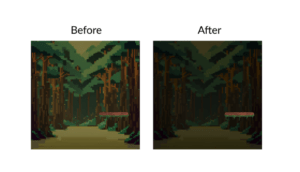
The image above represents the evolution of our background image, based on how much it blends into the foreground.
Onboarding:
The player, after the opening scene, is able to interact with animals on the map to learn more about the story and their role in the forest. This is how we chose to shape our narrative onboarding to make sure that players don’t get overwhelmed by a very long storyline before they can play.
The hint system is diegetic to the game, since the player mostly takes the advice of the wise turtle Oogway. At the start of the first level, players can see Oogway urging to “When in doubt, press E”. The question mark toggle also adds to this, allowing the players to learn more about the controls at their own pace.
Level design:
To have ludo-narrative cohesion with our level design, we made it so the player is able to use the spirit wood to (1) interact with spirit objects and (2) save the souls of the animals. The level is only done when the player “saves” all the animals, making the flag less translucent and signaling that they are able to finish the level.
For this, Eli hand-drew the levels and we talked about how it would make sense for the player to be forced to choose to use their spirit mode at the right time. By moving around platforms, thinking about where spirit activation would make sense, and considering how to make it a challenge for all animals to be saved, we were able to craft some levels with medium difficulty, so that the player would be pushed to think about how to correctly use the mechanics of the game.
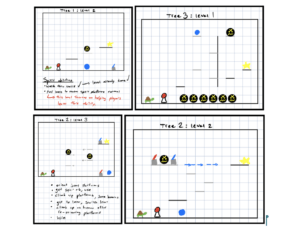
Architecture:
The setting of our game is in the forest.
The architecture in our game is used to support our game.
The animals sometimes serve as the constraints. For example, in the initial cutscene, we want the player to finish the entry-level tutorial (entering the first tree), so we use the turtle to block the bridge. The turtle only moves when the player finishes the first tutorial.
The border trees on the map also serve as the constraints to prevent the player from going out of the map.
Within the levels, we use the levers as obstacles and tests of player skills. Players need to use them in the correct way to pass the level.
Also, the trees in the map are used as level entries, while animals, and the wooden and rock bars within the levels, are all designed as architectural cliches. They are there to let the player resonate with the setting to be in the forest.
Game Architecture:
We use loops to help the player develop skills.
During our final iteration, our game aligns with the loop model well. We want the player to know how to use spiritwood, and how to interact with the environment. In the first tree, we use three levels with increasing difficulty to loop through the experience. Compared to previous iterations, where we used a spirit bar (passable in spirit mode) and spirit switch (unpassable in spirit mode), we’re switching to the final iteration where only introducing one mechanic in the three levels, but with more complex usage. This allows us to build player confidence in using such a mechanic before introducing another gameplay loop!
The arcs in our game are not very obvious right now, but when adding more trees and more levels, more stories will be revealed, and we’ll be able to deliver more evocative content.
Iterations
May 16th: Created bare-bone game structure on Unity
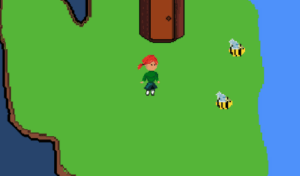
May 18th: Added interaction with the bees and basic level structures
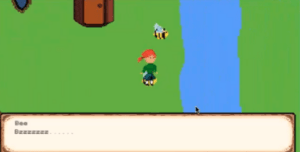
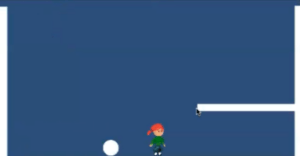
Player in lobby, interacting with bees Player in level, interactable ball, platform
May 18th-May 25th: Added opening scene, some animals, bridge, and refined the game puzzle scene
Playtesting 1
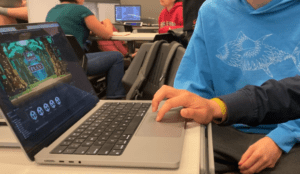
Guiding questions:
- Can players walk around the map and get into the puzzle through the tree door?
- Does the spirit mode work?
What is being tested:
Opening scene, the main character’s ability to walk around, talk to animals, enter the puzzle, and become a spirit.
Key Insights:
- Players walk “under” the bridge
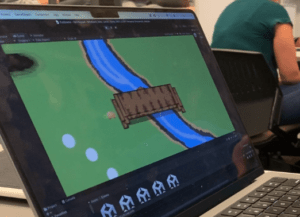
- Players walk outside the map
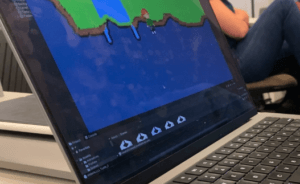
- Players get confused about the spirit mode, mainly because we haven’t changed the spirit-version of the character and explained there is a spirit mode
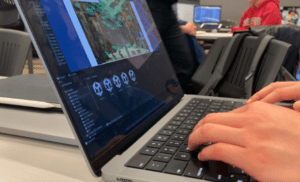
Changes:
- Need to add edge collider for the bridge
- Need to add box collider for the tree
- Edge of map needed
- Need to add more animals
- Need to add a spirit mode and explain it more
May 25th: Added more animals, new character design in different angles, music, and the spirit wood system
 (the white circles are placeholders for animals)
(the white circles are placeholders for animals)
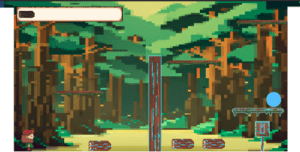 (Tested the spirit wood system)
(Tested the spirit wood system)
May 26: Refined dialogue, added music, and enabled walking in different directions
Playtesting 2
What is being tested?
Opening scene, player’s ability to navigate lobby freely, clarity of overall game objective,
Video of playtester in opening scene and lobby
The in-class playtest gave us some new insights. We realized that the intro dialogue would benefit from displaying character names in the dialog boxes instead of introducing the forest animals one by one. This is because the intro is mostly useful for conveying the concept to the players, and is not necessary for introducing the characters. This would help us avoid an unnecessarily long intro that bores new players. Additionally, it wasn’t very clear what to do when the dialog ended.
One player players also had difficulty perceiving their character’s movement using the ASDW or arrow keys, requiring adjustments to improve visibility. The other player did not, but indicated that he had played many similar games before. We decided not to add additional instructions for this, as the first player was able to find the arrow keys on the bottom right of the keyboard, which also work.
Both players expressed that talking to Master Oogway helped them navigate the learning curve of the game. The positive feedback on the initial Oogway interaction highlights the importance of establishing a precedent for engaging with characters before entering levels. To enhance gameplay understanding, we found it crucial to provide visual cues (such as the Spiritwood glow) or dialogue to guide players. Additionally, we resorted to incorporating a message about passing through Spiritwood as a soul-only ability to prevent accidental activation. We made some changes based on this, including:
- Shortening the opening dialog and delivering it in a more interactive way by having the player move around the lobby and interact with the animals to learn more about the story, fragmenting the story.
- Making it clear to the player what the objective is by having the turtle tell the player to go to the first tree (which then will launch them into the first tutorial puzzle).
- Adding a hint system through Master Oogway by adding hints such as “When in doubt, press E”.
Now that the player got to the level, he seemed to navigate the puzzle with absolute ease. Since this was our tutorial level, too, he seemed to pick up on the mechanics. Mainly, how to use the spiritwood, what becomes available to you in spirit form, how to jump/move, how to access hints (with the turtle), and how to complete the level.
Video of playtester in tutorial level
June 5th Iteration
Nearing the end of our work and after several playtests, we realized that spirit mode was too overpowered. Also, many players in the past have tried to complete the level as a spirit, something that wasn’t intended. This is because some aspects of our game were unbalanced: the player’s human form cannot interact with spirit levers and platforms, while the spirit mode can interact with everything.
To alleviate this, we made a last-minute level design change of making it so that spirits cannot jump onto non-spirit platforms, and we introduced “human levers” which only a human can interact with. This way, the two modes are effectively the inverse of each other, pushing the player to think critically about when to use their spirit mode. This also doubled down and emphasized core game mechanics that focused on the duality between each mode, and helped us design more interesting puzzles!

June 7th: Final Iteration
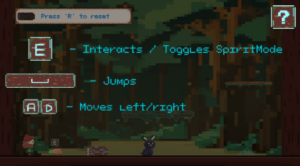
We added a question mark button on the upper right corner for players to easily see what keyboard buttons they should click to perform actions. Moreover, we highlighted the function of the button E in case players didn’t fully get the turtle’s hint at each level.
We also improved our hint system and made the hints from the turtle clearer at each level.
Moreover, during our final playtesting, we noticed that some players did not talk to the turtle and went straight into solving the puzzle. These players had a higher chance of getting stuck as compared to those who got the hint for the turtle. To ensure players get hints from the turtle, we moved the turtle to the right of the player’s starting point and had it face towards the player at the first level because we noticed that players needed the most scaffold as they first entered the puzzle.
Broader impact:
Although our game has no direct social commentary embedded in it, we did make subtle choices while thinking about its broader impact. For one, we wanted our main character to be female. We wanted to make this choice to contribute to normalizing a female default character in an industry still largely dominated by male characters presented as the sole option.
Additionally, the storyline of the game actually has metaphors that underpin themes of human-versus-nature and sustainability. The warlock who harnessed the spirit power then turned against the forest represents humanity harnessing the power of nature to use it for its destruction. Our main character symbolizes the hope for humanity to rectify its past mistakes and cooperate with nature to undo the damage it has done.
June 6: Final Playtest (Class 10A)
What is being tested?
The June 5th iteration, final puzzles, game narrative, playability, fun
Timestamps
1:06 – End of intro dialog
2:23 – Start of level 1
2:47 – Stuck at wall (confused moment #1)
3:12 – Level 1 complete/Level 2 starts
3:35 – Misclick “R” (confused moment #2)
3:52 – Toggle confusion (confused moment #3)
4:27 – Players thinking out loud about Level 2
5:11 – Strategy created to complete Level 2
5:37 – Level 2 complete
5:46 – Player notices the bridge is not blocked anymore – can access new portion of map
6:10 – Player talks to Master Oogway
6:15 – Player completes current version of game


